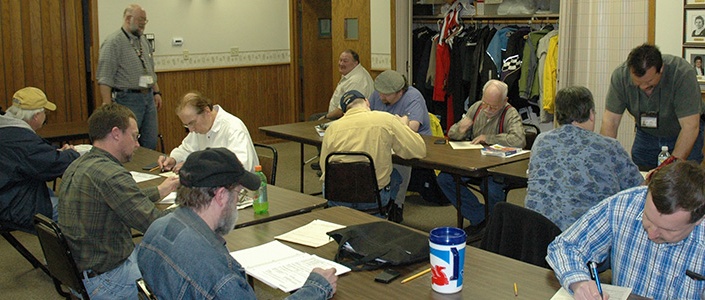For rally communications, you will need a Technician class license. This involves taking a 35-question multiple choice test on a variety of subjects — FCC rules and regs, simple electronics, basic theory on how radio waves work and propagate through the atmosphere, etc. There is a standard question pool, and the questions and answers are public. A passing grade is 74%, so you don’t have to be an expert on the material to pass. And unlike the old days, you do NOT need to know Morse code for any modern ham radio license class.
There are many ways to learn the material, depending on what works best for you. The classic method is to read a book, such as The ARRL Ham Radio License Manual. Another popular book is The Gordon West Technician Manual. Other options include HamRadioSchool.com’s Technician License Study Guide and The No-Nonsense Technician-Class Study Guide, which is also available as a free PDF file.
If online methods appeal to you more, you can take free practice tests using the same question pool as the actual license test until you know the questions and answers. Many web sites offer them, including the ARRL, eHam.net, and HamExam.org. Some sites, such as HamTestOnline.com, will help teach you the material at the same time as drilling you on it, which some find more helpful than just taking practice tests over and over.
For some, there’s just no substitute for a classroom setting. You can look up available license classes in your area on the ARRL web site. Some classes run one evening a week for several weeks. Others run over a single weekend or even a single day.
However you learn the material, you will need to take an official license exam in person. These are usually included at the end of license classes. There are also groups of volunteer examiners who hold exam sessions regularly across the country. Once again, the ARRL web site can help you find an exam session near you. You will need to bring identification, and $15.00 cash, check, or money order for the cost of the exam. You will also need to provide your Social Security number, or your FCC issued Federal Registration Number if you already have one. (You probably don’t, unless you already hold a different type of FCC license.) You are allowed to bring a calculator with no formulas in memory, but you probably won’t need this for the Technician license test.
The examiners will give you an exam booklet and a separate answer sheet to mark your answers. There is no time limit, so don’t rush. Be sure to mark your answers clearly, as the examiners use an answer key to score each test. When you’re done, an examiner will take your answer sheet. It will be graded immediately, and you’ll soon know whether you passed or failed. If you failed, many groups will allow you to “register” a second time, with another $15, and take the test again immediately (with different questions, of course). If you passed,
If you passed, congratulations! You now have the option of taking the General license test at no extra charge. You are welcome to do so, or not, as you wish. The Technician license grants you access to all of the frequencies you need for rally communications, but having access to more frequencies never hurts. If you pass the General test you can take the Extra, again at no extra charge. Though it’s rare for people to go from zero to Extra in one session, it does happen!
After passing, the examiners will do some paperwork. You will get a Certificate of Successful Completion of Element 2, which is the Technician written test, signed by three of your examiners. They will also submit your information to the FCC to have them issue you a license. Typically your callsign will appear in the FCC database within a week or so. As soon as your callsign is assigned, you are officially a ham radio operator and may go on the air immediately.
Once your license is issued, you simply need to keep your current address up to date in the FCC database if you move and renew it for free every ten years. You never need to take the test again unless you let your license expire for more than two years.

